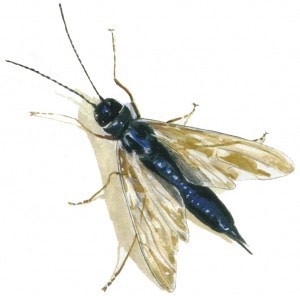
In February 2005, the identification of a European woodwasp, Sirex noctilio, that had been caught in an insect monitoring trap the previous September in Fulton, New York, near Lake Ontario, quickly got the worried attention of many forest entomologists. A number of Sirex larvae have been intercepted at shipping terminals, both before and after this capture, but when a free-living specimen of this notorious threat to pines was found out in the forest, it seemed safe to assume that this particular wayward female was not alone.
Like more than a dozen native woodwasps (they are also called horntails), this wasp lays eggs in trees, and when the larvae hatch, they spend their days excavating long tunnels within the tree, tunnels that increase in diameter as the resident grows. In temperate climates, European woodwasp larvae live for 10 to 11 months and then pupate just inside the bark. Adult horntails have barrel-shaped abdomens, with no sign of a wasp waist: they look like wasps with middle-age spread.
This newly-arrived horntail is a large, robust insect, 1 to 1.5 inches long, and a strong flier, with a high reproductive capacity. In mid-summer, as many as 450 eggs might be laid by a large female; smaller ones are much less fecund. Its preferred host trees are stressed pines, and vulnerable pine species are found throughout most of the U.S.
Many other insect species lay their eggs in the bark of trees, but the female European woodwasp takes the process a couple of steps further. She comes armed with sophisticated biological and chemical weapons, designed to ensure a prosperous future for her offspring. The biological weapon is a fungus called Amylostereum areolatum. The female wasp has a special little pocket that holds asexually produced fungal spores that she acquired as a larva, and she inserts these into a tree along with the eggs. The fungus then invades the tree and converts wood to a food that is easily digested by the developing larvae. Ultimately, it is the fungus, not the insect, that kills the host tree.
The wasp’s chemical weapon is a phytotoxic mucus, a potent blend of polysaccharide enzymes, oxidases, and proteolases that kills sapwood cells in the vicinity of the freshly laid egg, thus short-circuiting a tree’s defensive reactions – not unlike a burglar who cuts the phone lines before wresting open the bedroom window. Sirex noctilio differs from our native horntails in having a considerably larger mucus reservoir.
It would be overly charitable to say anything good about this recent arrival, but, fortunately, there is another angle – if not another side – to the story.
This woodwasp is native to Europe and parts of Asia, where it is considered just a minor pest, attacking only dead or dying trees. Its larvae perish if laid in a healthy tree. More than 100 years ago, it was inadvertently introduced into New Zealand, and, since then, it has also spread to Australia, South Africa, and several South American countries. Like so many pests introduced to new continents, it wreaks havoc away from home, and, together with its fungal accomplice, it has been responsible for killing over 80 percent of the trees in susceptible stands. In these countries, pine occurs mostly in plantations of North American species, especially Monterey and loblolly pine. Because Sirex noctilio has been so damaging for so long, successful strategies have been developed to thwart its arsenal of weapons.
A nematode – nematodes are microscopic worms that are often parasitic on other organisms – called Beddingia siricidicola has been remarkably effective at killing the European woodwasp, and it can be reared and deployed fairly easily. It infects the larvae and causes them to be sterile and unable to reproduce.
There are many species of insect parasitoids in North American that target horntails. They use their own ovipositors to insert their eggs right into the bodies of the succulent larvae of horntails, which kills the larvae and helps control the horntail species that have always lived here. Some of our species have been introduced to control Sirex in New Zealand. Together, parasitoids, nematodes, and management strategies to keep pines from being stressed have been successful. Woodwasp damage in New Zealand is now at a very low level.
A year after the upstate New York discovery, the European woodwasp had been found in several other counties and Canadian provinces. Capable of dispersing 18 to 25 miles each year, it appears to be here to stay. If we are very lucky, we will soon be grateful to New Zealanders for figuring out how to keep this particular insect under control. Until climate change or acid deposition changes growing conditions too much, our locally adapted pine species may be able hold their own. And perhaps our parasitoids, on their home turf, will take on this intruder more quickly.

